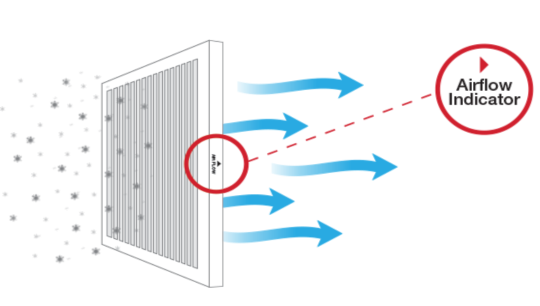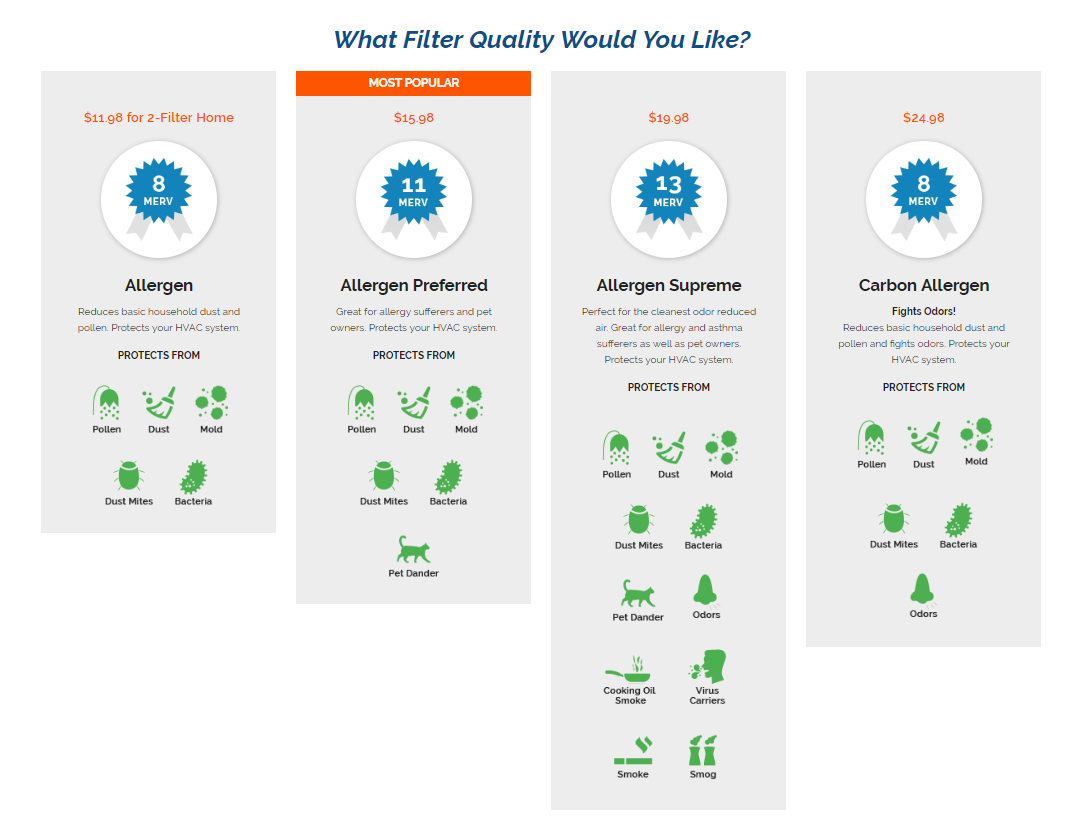- Why Indoor Air Gets Worse in the Winter (and What You Can Do About It)
- 5 Winter HVAC Mistakes You Might Be Making (and How to Fix Them)
- Is Your HVAC Ready for Winter? 5 Things to Check Before the First Cold Snap
- Breathe Happy This Thanksgiving: Why Air Quality Matters When You’re Hosting
- Fall Into Cleaner Air: 5 Reasons to Change Your Air Filter Before the Holidays

If you’re keeping up with HVAC maintenance, you’ll eventually come across something called a MERV rating. This is an important metric to pay attention to when shopping around for a filter.
Why?
Each home will require a different rating in order to assure your system runs as smoothly as possible
Factors such as how much airflow your system requires, if you have pets, and if a member of your family has severe allergies will determine which MERV rating you will need. Let’s learn more about what exactly these ratings are all about and how to figure out which you should consider.
What Does MERV Stand For?
MERV stands for Minimum Efficiency Reporting Value.
It is a rating system ranging from 1 - 16 used to compare filters made by various manufacturers. A MERV rating will let you know how many particles can escape through the filter and how efficiently air flow can move through your system. These particles are measured by microns.
MERV rating 1 is the lowest efficiency with minimum filtration. Rating 16 offers the highest efficiency and filtration.
Based on the numbers you might think the highest filtration is the best option. But that isn’t necessarily the case. If the filtration is too high, it could negatively affect your HVAC system in the house. Typically, household systems will only support MERV ratings 13 and lower. Anything above that is reserved for sterile buildings.
MERV ratings of 8 to 12 are usually the recommended values for your home. This rating helps remove a variety of particles from the house including:
- Pollen
- Dust mites
- Sanding dust
- Textile/carpet fibers
- Mold/spores
- Dust lint
- Cement dust
When are filters outside of this 8 - 12 threshold appropriate?
Well, each MERV rating was created for a different application. As we touched on, the highest filtration ratings (MERV 13 - 20) are typically used in sterile settings such as hospitals or laboratory settings. That’s due to the fact that these buildings need to filter out more than just pollen and dust particles; they also need to filter out bacteria, pathogens, and other microscopic contaminants. According to the EPA, MERV 16 can remove up to 99.97% of particles from the air.
The lowest ratings, MERV 1 - 8, are the least efficient at filtering out particles but they do allow for the lowest air resistance. These lower ratings can typically only trap some carpet fiber, pet dander, dust, and pollen. They aren’t the best at protecting you and your family from the full range of contaminants that could make their way into your home. Those with allergies may find these lower ratings aggravate their symptoms.
Comparing Popular MERV Ratings for Home Air Filters
It can be difficult choosing the right air filter for your home’s requirements and needs. If you need a visual breakdown of what MERV ratings look like for air filters, take a look at these comparison charts.
Here is a comparison chart of our MERV rating choices here at FilterTime:

What is a MERV 8 Air Filter?
Is a MERV 8 air filter good enough for your household? This depends. This level will filter out the basics: dust, mold, and pollen. It also offers a minimal pressure drop which will help protect your HVAC system. This filter will be ideal for families without severe allergies or pets. In other words, it’s a great standard filter for the average residential household.
What is a MERV 11 Air Filter?
MERV 11 filters are more efficient than MERV 8 filters as they can capture smaller particles. They offer additional protection from pet dander, dust mites, auto-emissions, and lung-damaging dust. This is a good option for households with pets or those looking for even better air quality than the MERV 8 can provide. It’s also our most popular air filter type.
What is a MERV 13 Air Filter?
Although most professionals recommend MERV 8 - 12 for home HVAC systems, we also provide MERV 13 air filters too. This rating is more efficient than the MERV 8 and 11 with the ability to filter out even more allergens from the air. If you or someone in your family has severe respiratory allergies, this will be a good filter option for you. This is the maximum MERV rating you’d want in your household. MERV 13 air filters cause a slight strain on your HVAC system’s operations since less air can pass through.
What MERV Rating Do I Need?
We recommend a MERV 11 rated air filter for your home. This is meeting in the middle between the 8 and 13 and tends to be the most popular choice for residential usage. For most households, this will be the perfect option to use year-round. It’s cheaper than MERV 13 but more efficient than a MERV 8 air filter. You also won’t be putting extra pressure on your furnace since the material mesh isn’t as dense as a higher MERV rating. Your furnace will last longer and your air quality will be healthier!
The best MERV rating for your home will depend on what you want to filter out and how much airflow your HVAC system needs to function. Since higher-rated filters allow less air to flow through your furnace, it’s a good idea to check if your system has a maximum MERV rating. The wrong type of air filter can force your furnace to work harder and increase the risk of it breaking down. Go to your furnace and read the manual or information stickers that talk about the max MERV rating.
If you want a better idea of what each rating has to offer, check out this handy MERV rating chart:
MERV Rating | Microns Blocked | Particles Blocked | Use |
MERV 1 - 8 | 3.0 - 10.0 microns | Carpet fiber, pet dander, dust, and pollen | Window unit Split unit Homes w/o pets |
MERV 9 - 12 | 1.0 - 3.0 microns | All of the above AND dust mites, lung-damaging dust, and auto-emissions | Typical home Allergy prevention Home w/ pets Home w/ fireplace |
MERV 13 - 16 | 0.30 - 1.0 microns | All of the above AND bacteria, viruses, and smoke particles | Hospitals Manufacturing Lab Setting |
MERV 17 - 20 | Less than 0.30 | All of the above AND radon, odor, microscopic allergens | Pharmaceutical Manufacturing Surgery Room |
The higher the MERV rating, the more excess pressure or air resistance the filter might put on your HVAC system. This static pressure is measured in a unit called “inch of water column” (i.w.c.). As we mentioned, certain HVAC systems can only take so much pressure so it’s important to check your manual to see how high of a MERV rating the manufacturer recommends.
Remember To Change Out Your Filter
The type of MERV rating isn’t the only thing you should keep in mind while maintaining your HVAC system. You should also remember to change out your filter regularly. We recommend that you change it out every 1 to 3 months. However, this does rely on the MERV rating you choose for your home, along with a couple of other factors. Also, the more pollen that’s in the air, the more often you should change it. This might change month to month as the pollen count fluctuates. You’ll also need to change it out more frequently if you have one or more pets.
To make this process easier for you, order from FilterTime and have your preferred air filter regularly delivered to your house! Cancel at any time! We offer a range of MERV ratings and only the highest quality filters! Satisfaction guaranteed every time.
« Back to News





